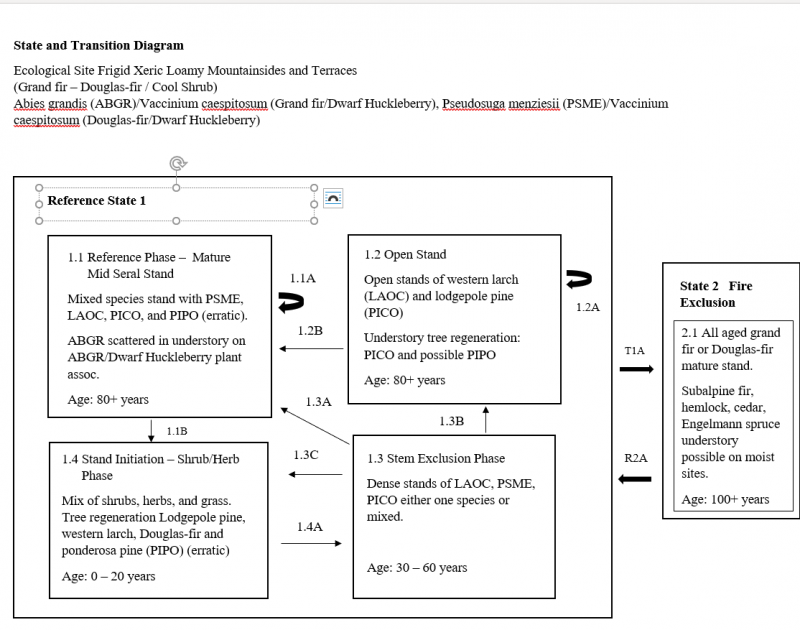
Natural Resources
Conservation Service
Ecological site F043AY586WA
Frigid, Xeric, Sandy, Outwash Terraces (Douglas-fir-Grand Fir Cool Shrub)
Last updated: 10/14/2020
Accessed: 12/07/2025
General information
Provisional. A provisional ecological site description has undergone quality control and quality assurance review. It contains a working state and transition model and enough information to identify the ecological site.
MLRA notes
Major Land Resource Area (MLRA): 043A–Northern Rocky Mountains
Description of MLRAs can be found in: United States Department of Agriculture, Natural Resources Conservation Service. 2006. Land Resource Regions and Major Land Resource Areas of the United States, the Caribbean, and the Pacific Basin. U.S. Department of Agriculture Handbook 296.
Available electronically at: http://www.nrcs.usda.gov/wps/portal/nrcs/detail/soils/ref/?cid=nrcs142p2_053624#handbook
LRU notes
Modal LRU – 43A01 Okanogan Plateau
This LRU is composed predominantly of mid to low elevation mountain slopes, foothills, structural benches and valley walls. The soils tend to be loamy andisols, or inceptisols and mollisols with distinct ash surfaces. Till, outwash and residuum/colluvium from granitic or metamorphic rock are the dominant parent materials. Soil climate is a frigid or cryic temperature regime and xeric moisture regime with average annual precipitation around 535 mm (21 inches).
Others where occurring – 43A02 – Western Selkirk Highlands
43A03 – Columbia-Colville Valleys
44A02 - Pend Oreille-Kootenai Valleys
Classification relationships
Relationship to Other Established Classifications:
United States National Vegetation Classification (2008) – A3362 Abies grandis – Pseudotsuga menziesii Central Rocky Mountain Forest & Woodland Alliance
Washington Natural Heritage Program. Ecosystems of Washington State, A Guide to Identification, Rocchio and Crawford, 2015 – Northern Rocky Mountain Mesic Montane Mixed Conifer Forest
Description of Ecoregions of the United States, USFS PN # 1391, 1995 - M333 Northern Rocky Mt. Forest-Steppe-Coniferous Forest-Alpine Meadow Province
Level III and IV Ecoregions of WA, US EPA, June 2010 – 15r Okanogan-Colville Xeric Valleys and Foothills, 15w Western Selkirk Maritime Forest, 15x Okanogan Highland Dry Forest, 15y Selkirk Mountains.
This ecological site includes the following USDA Forest Service Plant Association: PSME/VACA, and ABGR/VACA (Williams et. al. 1995)
Ecological site concept
Most commonly found in LRU 43A01 (Okanogan Plateau). This ecological subsite is associated with several soil components (e.g. Granflat and Wapal). The soil components are Vitrandic Haploxerolls and Vitrandic Haploxerepts. These soils have developed in mixed Mazama tephra deposits over coarse textured glacial outwash. The soils are very deep and have limitted available water capacity to a depth of 1 m. The soils are mostly somewhat excessively drained. Douglas-fir is the main tree component with western larch, lodgepole pine, and ponderosa pine (PIPO) (sporadic depending on frost). Grand fir will be minor component in the understory. Englemann spruce (PIEN) may be present on moist sites. Dwarf huckleberry is the key understory component along with bearberry, shiny-leaf spirea, serviceberry, twinflower, snowberry, pachistima, Utah honeysuckle, Oregon Grape, pinegrass, heartleaf arnica, feather solomonplume, and w. prince’s pine. In the moister grand fir portions of this site bunchberry dogwood, queencup beadlily, baldhip rose, russet buffaloberry, and western fescue can be present.
Table 1. Dominant plant species
| Tree |
(1) Pseudotsuga menziesii var. glauca |
|---|---|
| Shrub |
(1) Vaccinium membranaceum |
| Herbaceous |
(1) Calamagrostis rubescens |
Click on box and path labels to scroll to the respective text.

